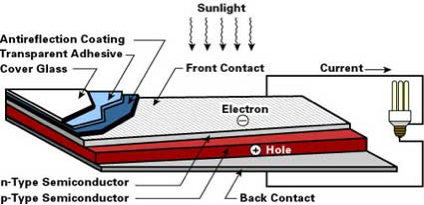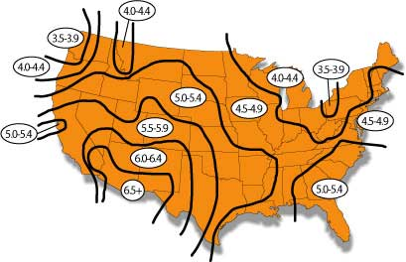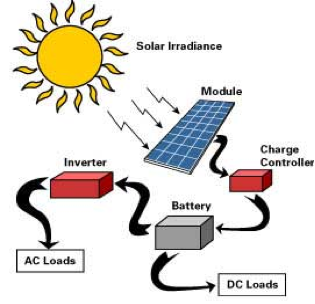Frequently Asked Questions
What is a residential solar electric system?
We offer comprehensive, code-compliant systems that allow you to generate your own electricity at home. Designed to interconnect with your existing utility service, they feature solar modules, plug-and-play wiring, power electronics and our patented mounting kits. Our installer network provides system installation and service.
How do solar cells generate electricity?

Photovoltaics or PV for short can be thought of as a direct current (DC) generator powered by the sun. When light photons of sufficient energy strike a solar cell, they knock electrons free in the silicon crystal structure forcing them through an external circuit (battery or direct DC load), and then returning them to the other side of the solar cell to start the process all over again. The voltage output from a single crystalline solar cell is about 0.5V with an amperage output that is directly proportional to cell's surface area (approximately 7A for a 6 inch square multicrystalline solar cell). Typically 30-36 cells are wired in series (+ to -) in each solar module. This produces a solar module with a 12V nominal output (~17V at peak power) that can then be wired in series and/or parallel with other solar modules to form a complete solar array to charge a 12, 24 or 48 volt battery bank.
Will solar work in my location?

Solar is universal and will work virtually anywhere, however some locations are better than others are. Irradiance is a measure of the sun's power available at the surface of the earth and it averages about 1000 watts per square meter. With typical crystalline solar cell efficiencies around 14-16%, that means we can expect to generate about 140-160W per square meter of solar cells placed in full sun. Insolation is a measure of the available energy from the sun and is expressed in terms of "full sun hours" (i.e. 4 full sun hours = 4 hours of sunlight at an irradiance level of 1000 watts per square meter). Obviously different parts of the world receive more sunlight from others, so they will have more "full sun hours" per day. The solar insolation zone map on the right will give you a general idea of the "full sun hours per day" for your location.
Will my system work on cloudy days?
Yes, though they produce less electricity. Under a light overcast sky, panels might produce about half as much as under full sun.
Will my system work at night?
No. Sunlight must be present for your solar modules to produce power. At night, you draw power from your utility.
How much will a system cost for my 2000 square foot home?
Unfortunately there is no per square foot "average" since the cost of a system actually depends on your daily energy usage and how many full sun hours you receive per day; And if you have other sources of electricity. To accurately size a system to meet your needs, we need to know how much energy you use per day. If your home is connected to the utility grid, simply look at your monthly electric bill. Using this information, a Green Apple Energy engineer can design a system to meet you needs.
What components do I need for a grid-tie system?
Grid-tie systems are inherently simpler than either grid-tie with battery back-up or stand-alone solar systems. In fact, other than safety disconnects, mounting structures and wiring a grid-tie system is just solar modules and a grid-tie inverter! Today's sophisticated grid-tie inverters incorporate most of the components needed to convert the direct current form the modules to alternating current, track the maximum power point of the modules to operate the system at peak efficiencies and terminate the grid connection if grid power is interrupted form the utility.
What components do I need?
There are many components that make up a complete solar system, but the 4 main items are: solar modules, charge controller(s), batteries and inverter(s). The solar modules are physically mounted on a mount structure (see question 7) and the DC power they produce is wired through a charge controller before it goes on to the battery bank where it is stored. The two main functions of a charge controller are to prevent the battery from being overcharged and eliminate any reverse current flow from the batteries back to the solar modules at night. The battery bank stores the energy produced by the solar array during the day for use at anytime of day or night. Batteries come in many sizes and grades. The inverter takes the DC energy stored in the battery bank and inverts it to 120 VAC to run your AC appliances.

What type of solar module mounting structure should I use?
There are four basic types of mount structures: roof/ground, top-of-pole, side-of-pole and tracking mounts, each having their own pros and cons. For example roof mount structures typically keep the wire run distances between the solar array and battery bank to a minimum, which is good. But they also require roof penetrations in multiple locations (a potential source of leakage) and they require an expensive ground fault protection (GFP- device to satisfy article 690-5 of the National Electrical Code- NEC). On the other hand, ground mounted solar arrays require fairly precise foundation setup, are more susceptible to theft/vandalism and excessive snow accumulation at the bottom of the array. Next are top-of-pole mounts which are relatively easy to install (you sink a 2-6 inch diameter SCH40 steel pole up to 4-6 feet in the ground with concrete). Make sure that the pole is plumb and mount the solar modules and rack on top of the pole. Top-of-pole mounts reduce the risk of theft/vandalism (as compared to a ground mount). They are also a better choice for cold climates because snow slides off easily. Side of pole mounts are easy to install, but are typically used for small numbers of solar modules (1-4) for remote lighting systems where there already is an existing pole to attach them to. Last but not least are the trackers, which increase the daily number of full sun hours and are used for solar water pumping applications. Trackers are extremely effective in the summer time when water is needed the most. In the northern U.S., typical home energy usage peaks in the winter when a tracker mount makes very little difference as compared to any type of fixed mount (roof, ground or top-of-pole). In this situation, having more modules on a less expensive fixed mount will serve you better in the winter than fewer modules on a tracker. However, if you are in the southern U.S. and your energy usage peaks in the summer, then a tracker may be beneficial to match the time of your highest energy consumption with a tracking solar array's maximum energy output.
Where should I mount the solar modules and what direction should I face them?

If your site is in the Northern Hemisphere you need to aim your solar modules to the true south direction (the reverse is true for locations in the Southern Hemisphere) to maximize your daily energy output. For many locations there is quite a difference between magnetic south and true south, so please consult the declination map below before you setup your mount structure. The solar modules should be tilted up from horizontal to get a better angle at the sun and help keep the modules clean by shedding rain or snow. For best year round power output with the least amount of maintenance, you should set the solar array facing true south at a tilt angle equal to your latitude with respect to the horizontal position. If you plan to adjust your solar array tilt angle seasonally, a good rule of thumb to go by is latitude minus 15° in the summer, latitude in the spring/fall and latitude plus 15° in the winter. Most mount structures provide for a seasonal adjustment of the tilt angle from horizontal to 65°. To determine if your proposed array site will be shaded at any time of the day or year you should consider using the Solar Pathfinder.
What happens during a power outage?
We offer two types of solar residential systems. One type of system powers your home during daylight hours, but does not provide power in an outage, even on a sunny day. Another type of system powers your home during daylight hours, but also has a battery backup designed to provide power to your home?s critical loads during an outage, day or night.
Does your solar system make hot water?
No. People often confuse our products with solar thermal panels that involve water circulating through tubes to be heated by the sun for swimming pool water heating. Our solar modules convert sunlight into electric current to operate appliances, motors, pumps and other devices.
How can I tell a water heating panel from a solar electric module?
Solar electric modules are typically one to two inches (2.5 to 5 cm) thick with 32 or more three to four inch (7.5 to 10 cm) blue or black solar cells on the back of the cover glass. Solar water heating panels are generally much thicker and may have tubes connected to a flat black plate under the glass, or a black tank inside the collector panel.
Can I generate heat for my home with a residential solar electric system?
No. Our solar power systems are designed to provide electricity to run your lights, appliances and other electric devices in your home. Other solar technologies are designed to turn the sun?s light into heat instead of electricity
What do the terms on-grid, grid-connected, grid-tied and off-grid mean?
On-grid, grid-connected or grid-tied means connected to the utility electrical grid. Our solar electric systems are designed as on-grid systems, meaning that they interconnect with your existing utility service. Off-grid refers to systems that are not connected to the utility electrical grid. Our solar electric packaged systems are not designed for off-grid applications. An off-grid system must be custom designed by a solar power expert.
How do I know if a residential solar electric system would work on my home?
Solar electric power works for most homes. Our systems are engineered to work with most roofing materials, in most locations where direct sunlight is available, in almost every region of the United States. You need a sunny place on your roof about 120 square feet or 11 sqaure meters (10 by 12 feet or 3 by 3.67 meters) for our smaller systems, and up to 1,000 square feet (93 square meters) for our largest systems. Shading from trees or other obstructions can reduce the practicality of a specific installation. A south-facing roof area is optimal, but solar electric panels can be mounted on west- or east- facing roofs and still produce better than 90 percent of the power of a true south roof mounting.
Why does it require at least 120 square feet (11 square meters) of roof space?
Each solar module is approximately 5 feet (1.5 meters) long and 2½ feet (0.75 meters) wide. The modules are always grouped in a set of four, and the minimum number of modules for our smallest system is twelve modules. This requires an area of at least 120 square feet (11 square meters).
Why is shade a problem?
Because of the wiring design of a solar module, all of the individual solar cells on a module must receive full sunlight for the module to work properly. If any portion of the module is shaded, the entire module power output-even those sections still exposed to sunlight-is lowered.
What if I need a new roof or am building a new house?
This is the ideal situation for installing solar. Before laying the roof, you can install flashable mounting brackets that provide the highest level of protection from leakage.
How many solar panels do I need to produce enough electricity to run my house?
The array size you need depends on your average electrical usage, climate, roof angle, shading problems and many other factors. To approximate the array size you need, multiply your average daily electrical demand in kilowatt-hours by 0.25. The result is the approximate size of solar array, in kilowatts, needed to meet your electrical demand.
Will a system produce enough energy to cover all my electricity needs?
It is important to understand that a solar electric system does not need to provide all of the electricity you need to be of great value. A small system that displaces an average of one-quarter to one-half of your average demand reduces your electric bill. With battery backup, it can deliver uninterrupted power to critical loads during utility outages for days or weeks. We are happy to provide you with a system that supplies 100 percent of your energy needs, but cutting your electricity by 40 to 50 percent is typically the most cost-efficient approach for home solar power.
What other options do I have if the system cannot be mounted on my roof?
If a roof-mounted system proves impractical, a ground-mount, trellis or pergola application may be an option.
What is net metering?
Net metering measures the difference between the electricity you buy from your utility and the electricity you produce with your solar energy system. Under net metering, any excess electricity produced by your solar energy system is delivered back into the utility grid, effectively spinning your meter backwards. Your meter spins forward when your solar energy system is not producing all of the electricity you are currently using. Your electric meter keeps track of this net difference as you generate electricity and take electricity from the utility grid.
Are government incentives available to reduce the price?
Yes. State agencies and municipal utilities offer rebate and incentive programs for homeowners and small businesses to promote the installation of renewable energy equipment such as ours. Incentives can cut the cost of your system in half, saving you thousands of dollars. Your dealer can tell you more about the incentives available in your area.
How much power will a residential system produce?
The amount of power produced by a system varies depending on the size of the system, your geographic location and climate and whether the system has a battery backup.
Can the modules withstand high winds and hail?
The panels are supported by our roofer-designed mounting system that has been tested to withstand 125 mph (200 kph) winds and can work on almost every type of roofing material. Our modules can withstand one inch (2.5 cm) hailstones at 50 mph (80.5 kph).
How long will my solar power system last?
With no moving parts and made of very inert materials, our solar modules are tough. Most of the related system components should also last for many years without problems. The batteries in our residential system may need replacement in five to 10 years
How can I tell how my system is performing?
We provide a power meter with the system. Located in your home, your power meter tells you exactly how much electricity you generate and use, and when you send power back to the utility grid. You will be able to manage your household usage like never before.
What maintenance does the system require?
You should go years without problems. The batteries in our residential system may need replacement every five to 10 years. We recommend that the installer do a system check once a year, just to make sure everything is performing as it should. If it is convenient, you can hose off the modules two or three times a year.
Do I need permission from the local utility to connect my solar system to the grid?
Yes. The local utility has rules and procedures that must be followed to connect any generator to the grid safely and legally. These rules are generally based on national standards with which our systems comply. Your dealer will help you with the documentation and procedures.
Can I have a solar electric system on my house and still be connected to city power?
Yes. In fact, our systems are designed as on-grid systems, meaning they are designed to interconnect with utility power.
